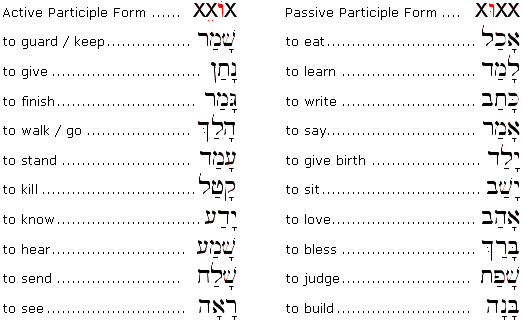|
Introduction to Hebrew Participles
Hebrew participles are "verbal adjectives," meaning that they function like adjectives though they are constructed from verbs. Participles use the same endings you have learned for nouns and adjectives, so learning their inflections is easy.
Hebrew participles have the following properties:
- Gender: (masculine or feminine)
- Number: (singular or plural)
- Definiteness: (article or no article)
- Voice: (active or passive)
The active voice indicates that the subject is the doer of the action:
"John hits the ball." (John acts, namely, by hitting the ball)
The passive voice indicates that the subject is acted upon by the verb:
"John was hit by the ball" (John is acted upon)
Notice that in English the voice of the verb changes the form of the verb: hits --> was hit. The same sort of thing happens in Hebrew, where you will see spelling changes for passive voice participles (in Biblical Hebrew, most participles you will encounter are Qal active participles (the simple or base form of a Hebrew verb is referred to as Qal (light)). Passive participles are relatively less used).
1. Active Participles
Like adjectives, participles must agree with the noun they modify in gender and number, and therefore can take four possible forms: two for masculine nouns (singular and plural), and two for feminine nouns (singular and plural). These forms are changed by means of adding endings to the stem of the word, in the same manner as endings are attached to nouns.
The basic pattern for the active participle is as follows:
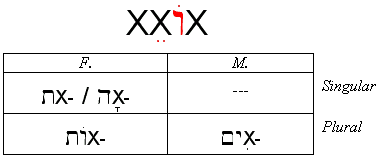
Notice that these are the same endings you studied for nouns and adjectives. What is different, however, is the schema showing "XXX" with a characteristic vowel pattern. These X's refer to the root letters of a given verb, and the Cholem Vav after the second letter is the characteristic "sign" of the qal active participle (note that the Cholem often appears instead of the Cholem Vav in the pattern, and this is known as defective spelling). An example should make this clear:
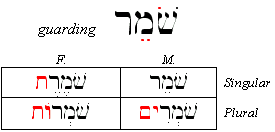
The vowel pattern for the root letters can vary depending on the "class" of verb (strong or weak) being inflected. For instance, the pattern for shamar, to guard is as folllows:
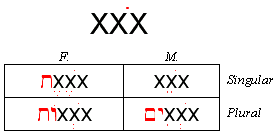
There may be slight variations in spelling that you will see with participle forms of verbs, but the Cholem (or Cholem Vav) between the first and second root letters remains constant throughout the inflections.
Additional Examples:
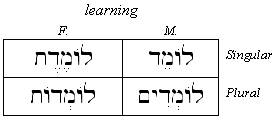
In this example, the root letters are Lamed, Mem, and Dalet. Notice how the participles are inflected according to gender and number.
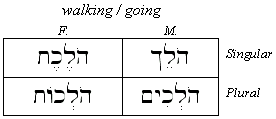
In this example, the root letters are Hey, Lamed, and Dalet. Again, notice how the vowel pattern applies to these root letters to form the active participle forms.
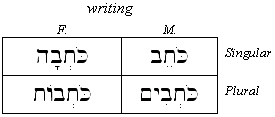
Notice that in this example, the feminine singular (fs) ending is Hey rather than Tav. This is fairly common. But note that the Cholem remains constant throughout the inflections.
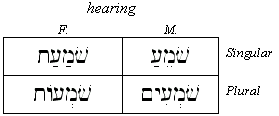
In the example above, the third letter of the root is Ayin, a guttural letter. This is known as a "weak" verb and vowel changes occur as a result (III-Guttural type verbs prefer a furtive Patach under the last letter). You will also see this pattern with the verb yadah, "to know."
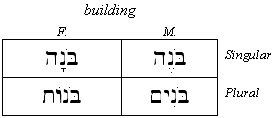
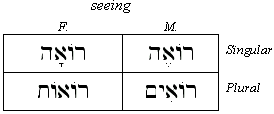
In the examples above, notice that the third letter of the root is a Hey, a guttural letter. Verbs with a third root letter that is Hey (III-Hey) drop out before endings are added, and vowel changes result. This is something you will just have to memorize. However, notice again that the characteristic Cholem Vav remains between the first two root letters throughout the inflections.
In short, you will need to be able to recognize the Qal active participle form for a verb when you are reading from the Tanakh. Often this is not as difficult as it may seem, since the form of the word you see in the text will indicate noun/adjective ending on a verb. In cases where you are unsure, you will need to resort to your lexicon to confirm the morphology of the word in question.
Uses of the Participle
Participles may be used in the following ways:
- As an adjective (a loving man); agrees with noun in gender, number, definiteness
- As a substantive (The one who loves is good); stands alone
- As a verb (The man loves the woman); subject normally precedes the participle
Adjectival Usage
When a participle is used as an adjective, it will modify a noun (or pronoun) with which it agrees in gender, number, and definiteness. These are the same rules as other Hebrew adjectives.

Examples:

In the example above, notice that the participle follows the noun and agrees in gender, number, and definiteness. We would translate this as "a sitting man" or "a man who is sitting."

In this example, notice that the participle follows the noun and agrees in gender, number, and definiteness. We would translate "the sitting woman" or "the woman who is sitting."
Substantival Usage
When a participle is used as a substantive, it will act like a noun. Note that participles can also function in word pairs, so they can take the characteristic "construct form" endings you will see on nouns.

Here the masculine singular participle stands in construct relation to the noun shalom. We would translate this "a guarder of peace."
Often participles will function as a noun meaning "the one(s) who."
Verbal Usage
A participle can also function as a verb in a clause. When so used, the participle will not agree with a noun in definiteness nor will it take the article. Present active participles express a "continuous" aspect regarding the action of the verb (but the tense or sense of time of the action is determined solely by context).

2. Passive Participles
The Qal passive participle occurs much less frequently than the active participle. It's basic pattern is as follows:
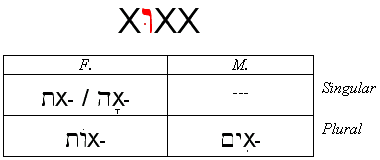
Notice again that these are the same endings you studied for nouns and adjectives. What is different, however, is the schema showing "XXX" with a characteristic vowel pattern. These X's refer to the root letters of a given verb, and the Shureq after the second letter is the characteristic "sign" of the qal passive participle (note that a Qibbuts may appear instead of the Shureq in the pattern). An example should make this clear:
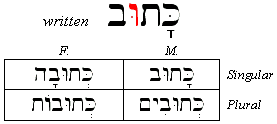
In general, the vowel pattern for the root letters can vary depending on the "class" of verb (strong or weak) being inflected, but in every case you will see the Shureq (or Qibbuts) between the second and third letters of the root of the word.
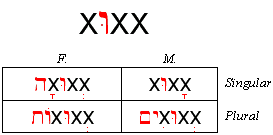
The passive participle is used in the same way as an active participle: as an adjective, a substantive, or as a verb:

Section Exercises
- Memorize the verbs listed in the section vocabulary at the top of the page. Create flashcards to help you recall the meanings (note that these forms are listed in the 3ms Qal Perfect form, the "lexical form" for the verbs).
- For each verb in the list, write out the four qal active participles forms (i.e., ms. mp, fs, and fp). Use a lexicon to confirm your work.
- Write a flashcard with the basic vowel patterns for the qal active and passive participle forms. Write the characteristic vowel for each (i.e., Cholem Vav for Qal Active, Shureq for Qal Passive).
- Memorize the qal passive participle forms for the verb katav.
- Write some simple examples to help you remember the rules.
<< Return
|
|



